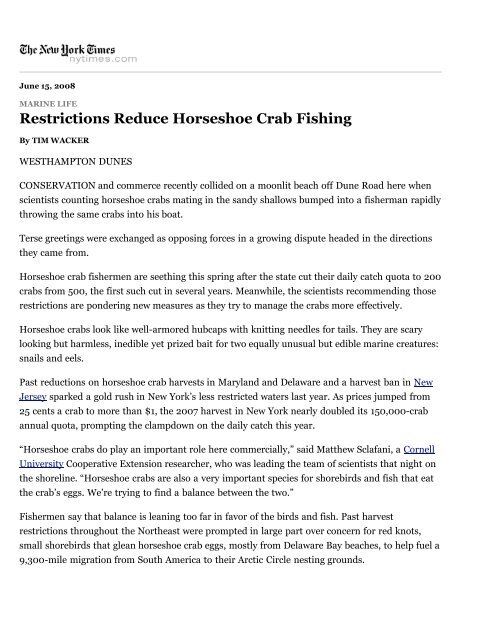Restrictions Reduce Horseshoe Crab Fishing - The Horseshoe Crab
Restrictions Reduce Horseshoe Crab Fishing - The Horseshoe Crab
Restrictions Reduce Horseshoe Crab Fishing - The Horseshoe Crab
You also want an ePaper? Increase the reach of your titles
YUMPU automatically turns print PDFs into web optimized ePapers that Google loves.
June 15, 2008MARINE LIFE<strong>Restrictions</strong> <strong>Reduce</strong> <strong>Horseshoe</strong> <strong>Crab</strong> <strong>Fishing</strong>By TIM WACKERWESTHAMPTON DUNESCONSERVATION and commerce recently collided on a moonlit beach off Dune Road here whenscientists counting horseshoe crabs mating in the sandy shallows bumped into a fisherman rapidlythrowing the same crabs into his boat.Terse greetings were exchanged as opposing forces in a growing dispute headed in the directionsthey came from.<strong>Horseshoe</strong> crab fishermen are seething this spring after the state cut their daily catch quota to 200crabs from 500, the first such cut in several years. Meanwhile, the scientists recommending thoserestrictions are pondering new measures as they try to manage the crabs more effectively.<strong>Horseshoe</strong> crabs look like well-armored hubcaps with knitting needles for tails. <strong>The</strong>y are scarylooking but harmless, inedible yet prized bait for two equally unusual but edible marine creatures:snails and eels.Past reductions on horseshoe crab harvests in Maryland and Delaware and a harvest ban in NewJersey sparked a gold rush in New York’s less restricted waters last year. As prices jumped from25 cents a crab to more than $1, the 2007 harvest in New York nearly doubled its 150,000-crabannual quota, prompting the clampdown on the daily catch this year.“<strong>Horseshoe</strong> crabs do play an important role here commercially,” said Matthew Sclafani, a CornellUniversity Cooperative Extension researcher, who was leading the team of scientists that night onthe shoreline. “<strong>Horseshoe</strong> crabs are also a very important species for shorebirds and fish that eatthe crab’s eggs. We’re trying to find a balance between the two.”Fishermen say that balance is leaning too far in favor of the birds and fish. Past harvestrestrictions throughout the Northeast were prompted in large part over concern for red knots,small shorebirds that glean horseshoe crab eggs, mostly from Delaware Bay beaches, to help fuel a9,300-mile migration from South America to their Arctic Circle nesting grounds.
As Delaware Bay horseshoe crabs’ numbers have dropped in recent years, so has the population ofred knots, prompting an outcry from environmental groups and causing some of the staterestrictions. <strong>The</strong>se days shorebirds face numerous environmental challenges, said Peter Wenczel, aSouthold bayman who is a member of the Atlantic States Marine Fisheries Commission’shorseshoe crab advisory board. One study found red knots died in South America from eatingmussels tainted from red tide algae toxins, he said.“It’s no doubt the world population of wading birds is down, but it’s not just because of horseshoecrab eggs,” he said.Fishermen harvesting bait for exotic seafood may not marshal public sentiment quite likeprotectors of shorebirds and prehistoric-looking crabs. But baymen are also becomingendangered, said Edward J. Warner Jr., a Southampton Town trustee and a seventh-generationbayman who fishes for horseshoe crabs and conch in Shinnecock Bay. New York State issued 360crab harvest permits in 2007.“<strong>The</strong>se days all the fisheries have quotas on them; I just want to keep the local fishermen going,”he said. “Last year you could get $500 in crabs, so it was economically viable to pick them up.<strong>The</strong>y should just let the fishermen catch the crabs and then, when they reach the annual limit, shutthe fishery down.”But that practice led to the near 90 percent overharvest last year, said Kim McKown, a crustaceansexpert with the New York Department of Environmental Conservation. <strong>Horseshoe</strong> crab researchhere lags far behind other states, she said, and until New York scientists know more about thehealth of New York populations they will be cautious.Along with the current quota reductions, the state has been closing known horseshoe crab nestingbeaches to fishing, and it is now developing research in the South Shore bays between theShinnecock and Moriches Inlets.“If there are areas of significant horseshoe crab and shore bird interactions,” Ms. McKown said,“then these are areas where it would be important to restrict the crab harvest in the future.”Copyright 2008 <strong>The</strong> New York Times Company








